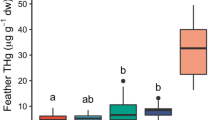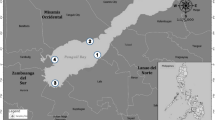Abstract
Metal (Al, As, Ca, Cd, Cu, Fe, K, Mg, Mn, Na, Pb, Zn) levels in the feeding organ or radula of the common limpet Patella vulgata L. were surveyed in 10 populations over a ~150-km stretch of coastline in north-east England. The most northern population was at Beadnell in Northumberland and the most southern was at Port Mulgrave in North Yorkshire; sites included unspoilt bays and areas heavily affected by industrial contamination such as the River Tees estuary. We hypothesized that the radula might be used as an indicator of environmental contamination. There were significant differences between the sites in the ratio of radula length to shell length. Limpets from Whitburn had the smallest radula fraction (mean = 1.665), while those from Port Mulgrave the largest (mean = 1.998). Such variation is common in the literature and we detected no correlate and propose no cause. Iron was clearly the dominant metal in the radulae, with an overall of mean of 1.46% of radular weight, though this is rather low in comparison to values in the literature. Iron is naturally secreted into the developing radula as a putative hardening agent. The next most abundant metals, in descending order, were Na (at ~2000–8000 μg g−1), K, Mg, Ca (~1000–1500 μg g−1), Zn, Cu, Al, Pb (~7–75 μg g−1), Mn, As, Cd (~0–1 μg g−1). All but Al and Cd showed significant differences between the sites, but not in any consistent or convincing geographic manner. Nevertheless, the variations in metal levels between sites (e.g. Fe > 72%, Cu and Zn > 10-fold) suggest an environmental cause, but we are unable to offer any responsible factor, for example, there appeared little effect of the River Tees estuary. Cadmium is at a relatively low level in the radula in comparison to published data on pedal mucus and the flesh, but Pb is relatively high in pedal mucus and the radula and this might suggest that the radula is a detoxification route for Pb. Although the relationship between radula metal content and environmental metal content is unknown, the radula is constantly replaced and so may yet have the potential to be of use as a bioindicator, integrating metal exposure over much shorter periods than whole body burdens.
Similar content being viewed by others
References
I.Y. Ahn K.W. Kim H.J. Choi (2002) ArticleTitleA baseline study on metal concentrations in the Antarctic limpet Nacella concinna (Gastropoda: Patellidae) on King George Island: variations with sex and body parts Mar. Poll. Bull 44 424–431
J. Appleton K. Lee K.S. Kapusta M. Damek M. Cooke (2000) ArticleTitleThe heavy metal content of the teeth of the bank vole (Clethrionomys glareolus) as an exposure marker of environmental pollution in Poland Environ. Poll 110 441–449
M.V. Brian G. Owen (1952) ArticleTitleThe relation of the radula fraction to the environment in Patella J. Anim. Ecol 21 241–249
R.R. Brooks M.G. Rumsby (1965) ArticleTitleThe biochemistry of trace element uptake by some New Zealand bivalves Limnol. Oceanogr 10 521–527
G.W. Bryan (1984) ArticleTitlePollution due to heavy metals and their compounds Mar. Ecol 5 1289–1431
G.W. Bryan L.G. Hummerstone (1977) ArticleTitleIndicators of heavy-metal contamination in the Looe Estuary (Cornwall) with particular regard to silver and lead J. Mar. Biol. Ass. UK 57 75–92
Bryan, G.W., Langston, W.J. and Hummerstone, L.G. (1980). The use of biological indicators of heavy metal contamination in estuaries, with special reference to an assessment of the biological availability of metals in estuarine sediments from South-West Britain. Marine Biological Association of the United Kingdom Occasional Publication No 1, 73 pp
Bryan, G.W., Langston, W.J., Hummerstone, L.G. and Burt, G.R. (1985). A guide to the assessment of heavy-metal contamination in estuaries using biological indicators. Marine Biological Association of the United Kingdom Occasional Publication No 4, 92 pp
M.A. Burford D.J. Macey J. Webb (1986) ArticleTitleHaemolymph, ferritin and radula structure in the limpets Patelloida alticostata and Patella peronii (Mollusca, Gastropoda) Comp. Biochem. Physiol. A 83 353–358
F. Cubadda M.E. Conti L. Campanella (2001) ArticleTitleSize-dependent concentrations of trace metals in four Mediterranean gastropods Chemosphere 45 561–569
M.S. Davies A.M. Hatcher (1999) ArticleTitleLimpet mucus as a depuration route and potential biomonitor Ecotoxicol 8 177–187
C. Díaz L. Galindo F. García-Montelongo M.S. Larrechi X. Rius (1992) ArticleTitleTrace metals in limpets (Patella sp) from the coast of Santa Cruz de Tenerife (Canary Islands) Bull. Environ. Contam. Toxicol 48 55–62
L.A. Evans D.J. Macey J. Webb (1991) ArticleTitleDistribution and composition of matrix protein in the radula teeth of the chiton Acanthopleura hirtosa Mar. Biol 109 281–286
E. Fischer-Piette (1935) ArticleTitleSystématique et biogéographie – les Patelles d’Europe et d’Afrique du Nord J. Conchyliologien 79 5–66
P. Foster J. Chacko (1995) ArticleTitleMinor and trace elements in the shell of Patella vulgata (L.) Mar. Environ. Res 40 55–76
V. Fretter A. Graham (1994) British Prosobranch Molluscs Ray Society London
Y. Fujioka (1985) ArticleTitleSeasonal aberrant radular formation in Thais bronni (Dunker) and T. clavigeri (Küster) (Gastropoda: Muricidae) J. Exp. Mar. Biol. Ecol 90 43–54
G.W. Grime F. Watt S. Mann C.C. Perry J. Webb R.J.P. Williams (1985) ArticleTitleBiological applications of the Oxford Scanning Proton Microscope Trends Biochem. Sci 10 6–10
S.J. Hawkins D.C. Watson A.S. Hill S.P. Harding M.A. Kyriakides S. Hutchinson T.A. Norton (1989) ArticleTitleA comparison of feeding mechanisms in microphagous herbivorous intertidal prosobranchs in relation to resource partitioning J. Moll. Stud 55 151–165
K. Hudson-Edwards M. Macklin M. Taylor (1997) ArticleTitleHistoric metal mining inputs to Tees river sediment Sci. Total Environ 194/195 437–445
B.T. Hyslop M.S. Davies W Arthur N.J. Gazey S. Holroyd (1997) ArticleTitleEffects of colliery waste on littoral communities in North-East England Environ. Poll 96 383–400
L.J. Johnson C.L.J. Frid (1995) ArticleTitleThe recovery of benthic communities along the County Durham coast after cessation of colliery spoil dumping Mar. Poll. Bull 30 215–220
B. Jones A. Turki (1997) ArticleTitleDistribution and speciation of heavy metals in surficial sediments from the Tees estuary, north-east England Mar. Poll. Bull 34 768–779
E.I. Jones R.A. McCance L.R.B. Shackleton (1935) ArticleTitleThe role of iron and silica in the structure of the radula teeth of certain marine molluscs J. Exp. Biol 12 59–64
K.-S. Kim J. Webb D.J. Macey D.D. Cohen (1986) ArticleTitleCompositional changes during biomineralization of the radula of the chiton Clavarizona hirtosa J. Inorg. Biochem 28 337–345
T.M. Leatherland J.D. Burton (1974) ArticleTitleThe occurrence of some trace metals in coastal organisms with particular reference to the Solent region J. Mar. Biol. Ass. UK 54 457–468
H.A. Lowenstam (1962) ArticleTitleGoethite in radular teeth of recent marine gastropods Science 137 279–280
S. Mann C.C. Perry J. Webb B. Luke R.J.P. Williams (1986) ArticleTitleStructure, morphology, composition and organization of the biogenic materials in limpet teeth Proc. Roy. Soc. Ser. B 227 179–190
P. Miramand D. Bentley (1992) ArticleTitleHeavy metal concentrations in two biological indicators (Patella vulgata and Fucus serratus) collected near the French nuclear fuel reprocessing plant of La Hague Sci. Total Environ 111 135–149
J. Navrot A.J. Amiel J. Kronfeld (1974) ArticleTitlePatella vulgata: a biological monitor of coastal metal pollution – a preliminary study Environ. Poll 7 303–308
G. Nickless R. Stenner N. Terrille (1972) ArticleTitleDistribution of cadmium, lead and zinc in the Bristol Channel Mar. Poll. Bull 3 188–190
F. Noël-Lambot J.M. Bouquegneau F. Frankenne A. Disteche (1980) ArticleTitleCadmium, zinc and copper accumulation in limpets (Patella vulgata) from the Bristol Channel with special reference to metallothioneins Mar. Ecol. Prog. Ser 2 81–89
D.K. Padilla D.E. Dittman J. Franz R. Sladek (1996) ArticleTitleRadular production rates in two species of Lacuna Turton (Gastropoda: Littorinidae) J. Moll. Stud 62 275–280
R.K. Pipe J.A. Coles (1995) ArticleTitleEnvironmental contaminants influencing immune function in marine bivalve mollusks Fish Shellfish Immun 8 581–595
Portmann, J.E. (1979). Chemical monitoring of residue levels in fish and shellfish landed in England and Wales during 1970–73. Aquatic Environment Monitoring Report, MAFF Directorate of Fisheries Research No. 1, 70 pp
A. Preston D.F. Jefferies J.W.R. Dutton B.R. Harvey A.K. Steele (1972) ArticleTitleBritish Isles coastal waters: the concentrations of selected heavy metals in sea water, suspended matter and biological indicators – a pilot survey Environ. Poll 3 69–82
G.J. Ramelow (1985) ArticleTitleA study of heavy metals in limpets (Patella sp.) collected along a section of the southeastern Turkish Mediterranean coast Mar. Environ. Res 16 243–253
N.W. Runham (1961) ArticleTitleThe histochemistry of the radula of Patella vulgata J. Microsc. Sci 102 371–380
N.W. Runham P.R. Thornton D.A. Shaw R.C. Wayte (1969) ArticleTitleThe mineralization and hardness of the radular teeth of the limpet Patella vulgata L Z. Zell. Mikros. Anat 99 608–626
D.A. Segar J.D. Collins J.P. Riley (1971) ArticleTitleThe distribution of the major and some minor elements in marine animals Part. II: molluscs J. Mar. Biol. Ass. UK 51 131–136
T.G. St Pierre S. Mann J. Webb D.P.E. Dickson N.W. Runham R.J.P. Williams (1986) ArticleTitleIron oxide biomineralization in the radula teeth of the limpet Patella vulgata; Mössbauer spectroscopy and high resolution transmission electron microscopy studies Proc. Roy. Soc. Ser. B 228 31–42
J.F.V. Vincent (1980) ArticleTitleThe hardness of the tooth of Patella vulgata L. radula: a re-appraisal J. Moll. Stud 46 129–133
Author information
Authors and Affiliations
Corresponding author
Rights and permissions
About this article
Cite this article
Davies, M.S., Proudlock, D.J. & Mistry, A. Metal Concentrations in the Radula of the Common Limpet, Patella vulgata L., from 10 Sites in the UK. Ecotoxicology 14, 465–475 (2005). https://doi.org/10.1007/s10646-004-1351-8
Accepted:
Issue Date:
DOI: https://doi.org/10.1007/s10646-004-1351-8




